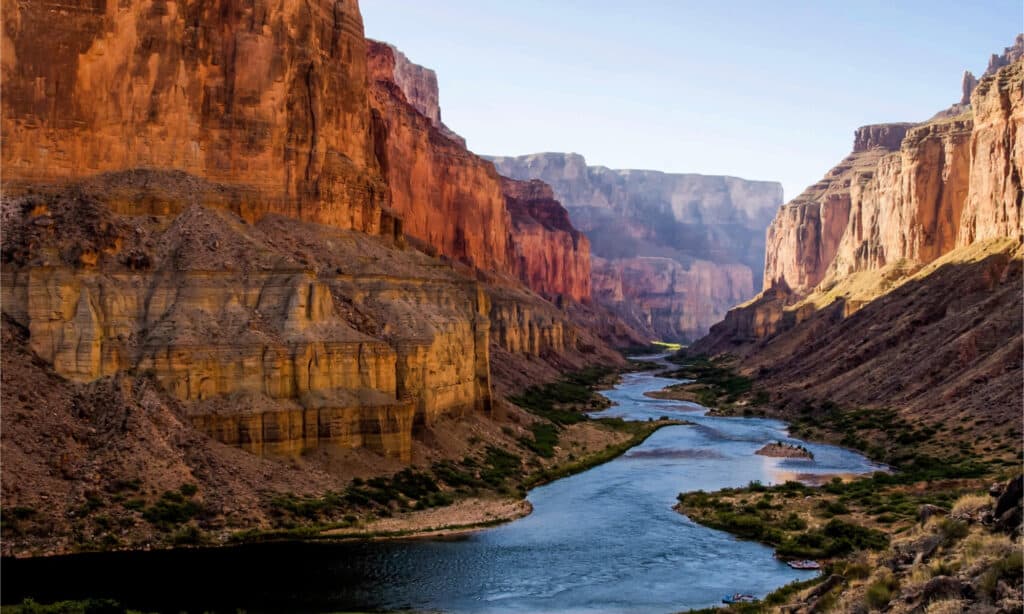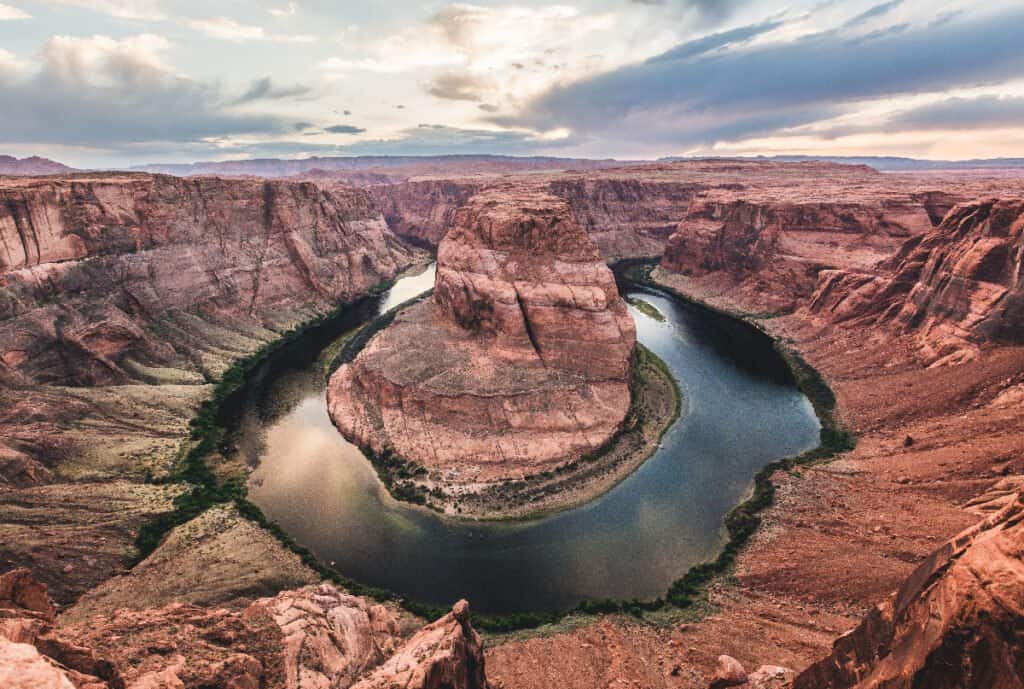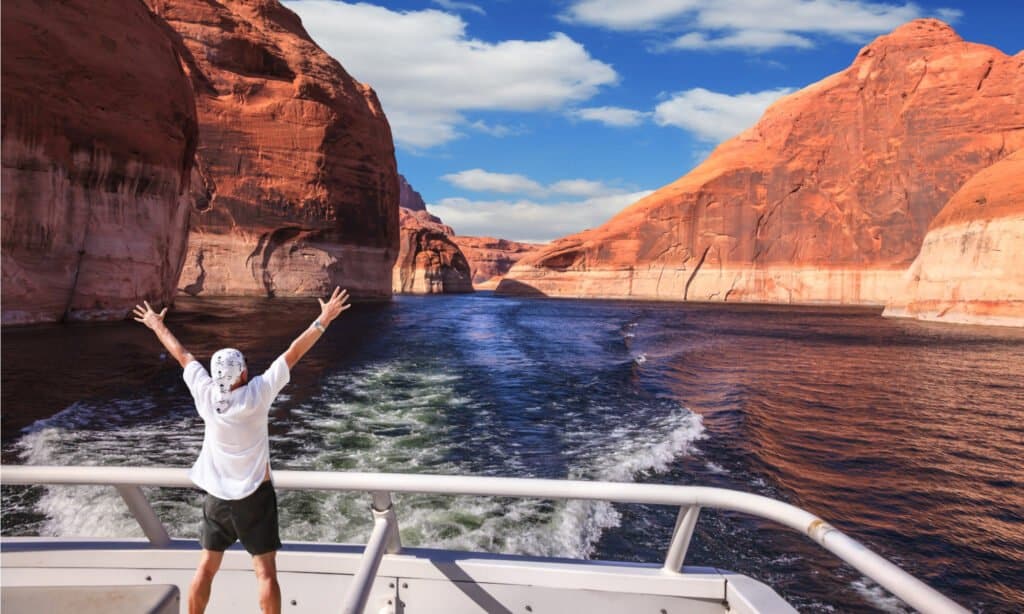Referred to as the “Lifeline of the Southwest,” the magnificent Colorado River drains a massive sector of North America. Best known for the beautiful canyons it flows through and its whitewater rapids, the river is one of the principal rivers in the Southwestern United States and northern Mexico.
What is the widest point on the Colorado River? What is the narrowest part? Where does the river start and end? In this article, you’ll find the answers to these questions and more!
Where is the Colorado River Located?

For 17 miles, the Colorado River forms the international boundary between the U.S. state of Arizona and Mexico.
©Beth Ruggiero-York/Shutterstock.com
The Colorado River is located between the southwestern United States and northern Mexico. This long river drains a vast, arid watershed that runs through seven U.S states namely – California, Colorado, Arizona, Utah, Wyoming, New Mexico, Nevada– and two Mexican states. For 17 miles, the river forms the international boundary between the U.S. state of Arizona and Mexico.
What is the Widest Point on the Colorado River?

The widest point of the Colorado River is at Grand Junction, Colo, measuring 200 feet wide.
©Markue/Shutterstock.com
The Colorado River is widest at Grand Junction, Colo which is 200 feet wide. The river reaches about 50 feet wide for the first 50 miles. Ranging from 200 to 500 feet wide, most of the upper river is a swift whitewater stream. Colorado River has an average width of 300 feet across, although it becomes narrower at Mile 135 to only 76 feet wide. This is where the river is also at its deepest.
What is the Narrowest Part of the Colorado River?
The Granite Narrows of the Grand Canyon is the narrowest part of the Colorado River. It is a stretch of the Colorado River at the bottom of the Grand Canyon. It is only 76 feet wide, the narrowest section of the river, hence its name.
What is the Deepest Point on the Colorado River?

The deepest point on the Colorado River is at Mile 135, reaching a depth of 85 feet.
©kavram/Shutterstock.com
The average depth of the Colorado River is 20 feet, but there are deep holes that are as far as 90 feet deep. In some places, the river is just 6 feet deep and it is made up of a combination of thrilling rapids and calm flowing water. According to Douglasma, the Colorado River is deepest at Mile 135, reaching 85 feet deep. As we said, this also happens to be the narrowest point of the river. The Colorado River is about 30 feet deep in the lower stretches of the Grand Canyon. But in the upper reaches above the Grand Junction, Colo, it is not more than 10 feet deep. On average, the Colorado River within the Grand Canyon is 40 feet deep.
Where Does the Colorado River Start and End?
The Colorado River starts its flow from La Poudre Pass in the Southern Rocky Mountains of Colorado and empties into the Gulf of California to end its course. The river’s source is La Poudre Pass Lake, located high in Rocky Mountain National Park, just west of the Continental Divide. Along its course, the Colorado River flows through the Kawuneeche Valley and then flows through Grand Lake, the largest natural body of water in Colorado. It then flows through the Grand Canyon before reaching Lake Mead on the Arizona–Nevada border. It finally ends its journey at the tip of the Gulf of California, between Baja California and Sonora.
What is the Length of the Colorado River?
The Colorado River is approximately 1,450 miles long from its headwaters at La Poudre Pass to its mouth in the Gulf of California in northwestern Mexico. It ranks 6th on the list of U.S. rivers that are more than 100 miles long.
What is the Speed of the Colorado River?
Within Grand Canyon National Park, the Colorado River’s 277 miles flow at an average speed of four miles per hour. The river’s flow rate is about 8 million gallons per minute near Lees Ferry, Ariz. But at the mouth, it is about 2 million gallons per minute.
How Many Species of Fish are in the Colorado River?
Rivers and streams in the Colorado basin were once home to 49 species of native fish, of which 42 were endemic. However, regulations and engineering projects in the river have led to the extinction of some species and severe declines in the populations of about 40 species. Four of these species are particularly listed as endangered; Colorado pikeminnow, ponytail chub, razorback sucker, and humpback chub. They are all unique to the Colorado River network and well adapted to the river’s natural conditions.
Are There Two Colorado Rivers?
Unbeknownst to most people, there are two Colorado Rivers in the world. The first is the Colorado River that everyone knows, having carved its way through the rock to create the Grand canyons. Then, the other is the Colorado River which carves its way entirely through Texas. Its waters still flow to the Gulf of Mexico. At over 800 miles long, the Texas Colorado River is one of the longest rivers to start and end in just one state. It is important to note that this is NOT the same Colorado River that flows through Arizona, Utah, and other western U.S states.
5 Amazing Facts about the Colorado River
- The Colorado River is the 5th longest river in the United States of America and the 47th longest river in the world.
- Between 1931 and 1936, the Hoover Dam was built on the Colorado River to control the river, generate electricity, and supply drinking water.
- The Colorado River is a vital source of water for more than 40 million people in the southwest United States.
- In its typical state, the Colorado River spills about 20.1 cubic kilometers (16.3 million acre-feet) into the Gulf of California each year, making an average flow rate of 22,500 cubic feet per second.
- The Colorado River and its tributaries – the Gunnison, the Green, the Virgin, the San Juan, the Gila Rivers, and Little Colorado- are collectively called the “Colorado River Basin.”
The photo featured at the top of this post is © kavram/Shutterstock.com
Thank you for reading! Have some feedback for us? Contact the AZ Animals editorial team.






